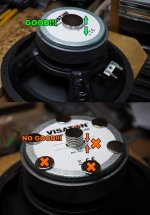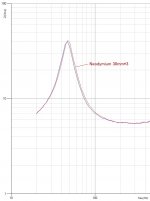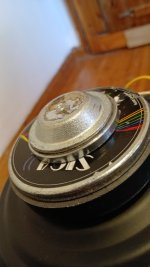Neodymium magnets work best when they are attached in a direction that repels the center of the magnet backing.(Visaton BG20)
YouTube-[Air-Recording] Little Wing | Kanae Izutsu
<iframe width="560" height="315" src="
" title="YouTube video player" frameborder="0" allow="accelerometer; autoplay; clipboard-write; encrypted-media; gyroscope; picture-in-picture" allowfullscreen></iframe>
YouTube-[Official Sound] Little Wing | Kanae Izutsu
<iframe width="560" height="315" src="
" title="YouTube video player" frameborder="0" allow="accelerometer; autoplay; clipboard-write; encrypted-media; gyroscope; picture-in-picture" allowfullscreen></iframe>
YouTube-[Air-Recording] Little Wing | Kanae Izutsu
<iframe width="560" height="315" src="
YouTube-[Official Sound] Little Wing | Kanae Izutsu
<iframe width="560" height="315" src="
Attachments
OMG that great an improvement sounds so goodNeodymium magnets work best when they are attached in a direction that repels the center of the magnet backing.(Visaton BG20)
YouTube-[Air-Recording] Little Wing | Kanae Izutsu
<iframe width="560" height="315" src="" title="YouTube video player" frameborder="0" allow="accelerometer; autoplay; clipboard-write; encrypted-media; gyroscope; picture-in-picture" allowfullscreen></iframe>
YouTube-[Official Sound] Little Wing | Kanae Izutsu
<iframe width="560" height="315" src="" title="YouTube video player" frameborder="0" allow="accelerometer; autoplay; clipboard-write; encrypted-media; gyroscope; picture-in-picture" allowfullscreen></iframe>
So it has to be place at the center of the poles pc in repel fashion. What glue do you use to keep the magnet in placed.OMG that great an improvement sounds so good
I saw a huge 4cm diameter Neodymium magnet which might be good too experiment with
Thank you
Neodymium magnets are so strong that they cannot be removed.
FE126En (1kg) can be lifted with 6 * 16mm neodymium magnets.
<iframe width="560" height="315" src="
" title="YouTube video player" frameborder="0" allow="accelerometer; autoplay; clipboard-write; encrypted-media; gyroscope; picture-in-picture" allowfullscreen></iframe>
FE126En (1kg) can be lifted with 6 * 16mm neodymium magnets.
<iframe width="560" height="315" src="
Some production drivers have been equipped with double magnets, primarily to minimize how far the magnetic field spread and avoid CRT picture distortion when speakers were placed too close, but the efficiency often increased as a side-effect. This pair (with ferrite rather than neodymium magnets) is by Trio-Kenwood.

No problem.
There are many kinds of Ferrites, some soft some hard.
Imagine you wind a coil around a piece of ferrite and pass current through it.
It will try to magnetize the core, but results will be very different.
Vertical axis: magnetizing force (proportional to current through coil); horizontal axis: effective material magnetization.
Both will rise at first, then reach a limit (curve becomes almost horizontal) and go no further, that limit means saturation and both materials *are*magnetized.
The big difference appears when you remove external magnetization (cut coil current off).
A soft material returns to "almost" zero, the small error is called hysteresis and causes losses in the core, but it can be used for transformers, tuned coils, chokes, etc.
Same applies to silicon steel.
The hard material will keep magnetization, A LOT of it, even when coil current becomes zero.
Hence, it is a permanent magnet.
It is very difficult to magnetize (magnetizers are big, expensive and power hungry) and also to de-magnetize. Applies to Alnico, Barium and Strontium Ferrites and Rare Earth magnets (Samarium Cobalt, Neodymium, etc.)

.
There are many kinds of Ferrites, some soft some hard.
Imagine you wind a coil around a piece of ferrite and pass current through it.
It will try to magnetize the core, but results will be very different.
Vertical axis: magnetizing force (proportional to current through coil); horizontal axis: effective material magnetization.
Both will rise at first, then reach a limit (curve becomes almost horizontal) and go no further, that limit means saturation and both materials *are*magnetized.
The big difference appears when you remove external magnetization (cut coil current off).
A soft material returns to "almost" zero, the small error is called hysteresis and causes losses in the core, but it can be used for transformers, tuned coils, chokes, etc.
Same applies to silicon steel.
The hard material will keep magnetization, A LOT of it, even when coil current becomes zero.
Hence, it is a permanent magnet.
It is very difficult to magnetize (magnetizers are big, expensive and power hungry) and also to de-magnetize. Applies to Alnico, Barium and Strontium Ferrites and Rare Earth magnets (Samarium Cobalt, Neodymium, etc.)

.
The pole piece is made of soft magnetic material, and as JMFahey explained it goes in saturation. This determines the magnetic flux density B in the gap. It simply will not go beyond a certain value, regardless of the permanent magnet "strength" or magnetizing force H.
Ive added a large 25mm x 10mm neodymium magnet to a diatone p610 clone. It increases sound output. Higher sensitivity in a linear way.
It sounds best on the side of the magnet, on the ferrite itself though, co planar magnetic fields, stuck to the side of each other with just magnetic force and complementary fields.
Seems like 6 of them would be a very big difference, almost like a neodymium made speaker itself, just WITH the ferrite too.
Why would these see more improvement with magnetic field on the ferrite surface, vs on the back of the magnetic filed collimator thingy..?
It sounds best on the side of the magnet, on the ferrite itself though, co planar magnetic fields, stuck to the side of each other with just magnetic force and complementary fields.
Seems like 6 of them would be a very big difference, almost like a neodymium made speaker itself, just WITH the ferrite too.
Why would these see more improvement with magnetic field on the ferrite surface, vs on the back of the magnetic filed collimator thingy..?
Tried this with Sica 10D1CS using the magnet off a LaVoce FSN 3 inch driver, it repelled first then snapped on very tightly once it got within a cm... its a strong magnet.
I tried making a basic phone recording, the driver naked lying on table, with and without magnet, there is a fairly significant effect, the bass reduces, due to lower Qts in this baffleless test setup. I think also detect more output in the upper end.
Recording is attached
Will put in a box soon and have an actual listen
I tried making a basic phone recording, the driver naked lying on table, with and without magnet, there is a fairly significant effect, the bass reduces, due to lower Qts in this baffleless test setup. I think also detect more output in the upper end.
Recording is attached
Will put in a box soon and have an actual listen
Attachments
The German magazine Klang&Ton once published an interesting speaker design where they added a magnet to the back of a visaton bg20 and i seem to remember to remember that they had measurements before and after to compare. Will see if I can dig it up.
This isn't a simple modification with predictable results. The first issue is that the speaker design includes pole pieces that are used to concentrate the magnetic flux in the gap where the voice coil is. A speaker is a type of linear motor, whose output power is proportional to the current flow in the voice coil multiplied by the magnetic flux (it actually is even more complicated than that because the force on the voice coil is calculated using a vector cross product).
So the built-in magnet/pole piece system has ferromagnetic components. It is made with a steel alloy which has a particular Bsat -- basically, the maximum amount of magnetic induction it can sustain. Adding an external magnet will increase the magnetic field in some regions of that ferromagnetic structure, but they are a long ways away, relatively speaking, from the voice coil gap. Increasing the magnetic field someplace else could well move portions of the magnetic "circuit" into their Bsat range. When that happens, the magnetic field will leak out -- it won't be completely routed to the voice coil. This is related to its relative permeability, see more below.
This could reduce the speaker's voicecoil response to an electrical input, because the mag-field intensity in the gap will be lower.
Another issue is that it's not obvious that just tacking a magnet onto the back of a speaker will substantially increase the magnetic field around the voice coil. This is due to another factor. Magnetic structures can be viewed as a kind of electrical circuit, where the magnet is similar to a voltage source. That is its total flux available. -Ferromagnetic materials' permeability is analogous to conductivity-. Materials like soft iron may have a relative permeability in the range of 5,0000 while air is 1. Since we're talking conductivity here, that means that air is more "resistive" to magnetic fields. So it only takes a small air gap to greatly reduce the amount of magnetic flux in your magnetic circuit. Sticking a magnet onto the back of a speaker means that the back of the magnet is.....in air. So its effect, in terms of possibly increasing the mag-field across the voice coil, isn't going to be very high. Portions of the pole structure that were moved into their Bsat region also will behave as though THEY are air, so that could be a big problem (see the last sentence of paragraph 2).
The other factor is that the pole pieces are designed to direct the mag-field from the speaker's magnet, not from some external magnet. A lot of the pole-piece structure will, in essence, short-out the mag field the external magnet is trying to jam into the pole gap. I doubt that much flux from the added magnet would make it to the pole gap.
So....after this long-winded exposition, my conclusion is: it's not going to do much, if anything, to make the speaker perform "better". It may actually degrade its performance.
Your observation that adding a magnet reduced the bass response suggests that it may well have moved portions of the speaker's pole structure into its Bsat region. It would be interesting to flip the magnet around to see if that changes things. I wouldn't expect it to improve the speaker's original performance but it (probably) wouldn't degrade the performance as much. I'd be very interested in what you observe. I can think of one possible situation where things might get better but it would be totally dependent on the speaker design, where some components are operating close to or in their Bsat range.
So the built-in magnet/pole piece system has ferromagnetic components. It is made with a steel alloy which has a particular Bsat -- basically, the maximum amount of magnetic induction it can sustain. Adding an external magnet will increase the magnetic field in some regions of that ferromagnetic structure, but they are a long ways away, relatively speaking, from the voice coil gap. Increasing the magnetic field someplace else could well move portions of the magnetic "circuit" into their Bsat range. When that happens, the magnetic field will leak out -- it won't be completely routed to the voice coil. This is related to its relative permeability, see more below.
This could reduce the speaker's voicecoil response to an electrical input, because the mag-field intensity in the gap will be lower.
Another issue is that it's not obvious that just tacking a magnet onto the back of a speaker will substantially increase the magnetic field around the voice coil. This is due to another factor. Magnetic structures can be viewed as a kind of electrical circuit, where the magnet is similar to a voltage source. That is its total flux available. -Ferromagnetic materials' permeability is analogous to conductivity-. Materials like soft iron may have a relative permeability in the range of 5,0000 while air is 1. Since we're talking conductivity here, that means that air is more "resistive" to magnetic fields. So it only takes a small air gap to greatly reduce the amount of magnetic flux in your magnetic circuit. Sticking a magnet onto the back of a speaker means that the back of the magnet is.....in air. So its effect, in terms of possibly increasing the mag-field across the voice coil, isn't going to be very high. Portions of the pole structure that were moved into their Bsat region also will behave as though THEY are air, so that could be a big problem (see the last sentence of paragraph 2).
The other factor is that the pole pieces are designed to direct the mag-field from the speaker's magnet, not from some external magnet. A lot of the pole-piece structure will, in essence, short-out the mag field the external magnet is trying to jam into the pole gap. I doubt that much flux from the added magnet would make it to the pole gap.
So....after this long-winded exposition, my conclusion is: it's not going to do much, if anything, to make the speaker perform "better". It may actually degrade its performance.
Your observation that adding a magnet reduced the bass response suggests that it may well have moved portions of the speaker's pole structure into its Bsat region. It would be interesting to flip the magnet around to see if that changes things. I wouldn't expect it to improve the speaker's original performance but it (probably) wouldn't degrade the performance as much. I'd be very interested in what you observe. I can think of one possible situation where things might get better but it would be totally dependent on the speaker design, where some components are operating close to or in their Bsat range.
- Home
- Loudspeakers
- Full Range
- Adding neodymium magnets


